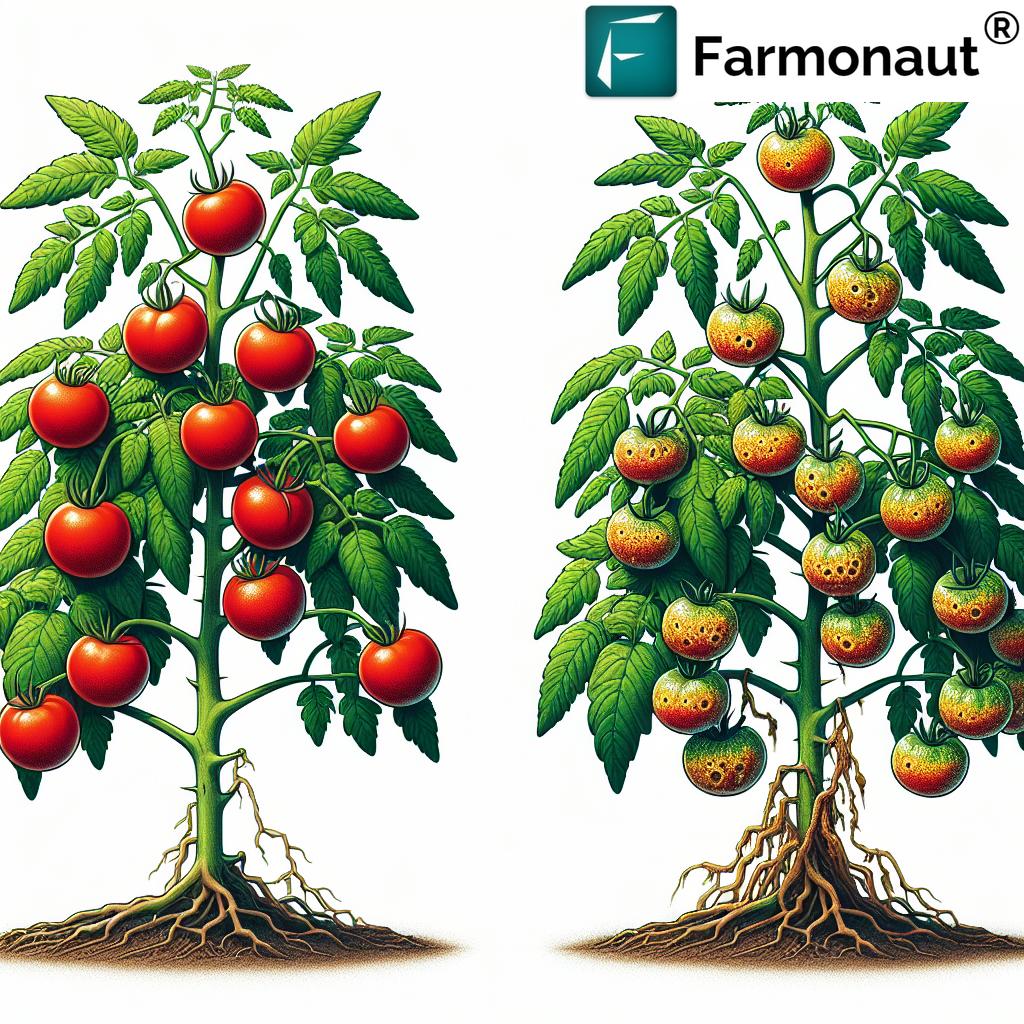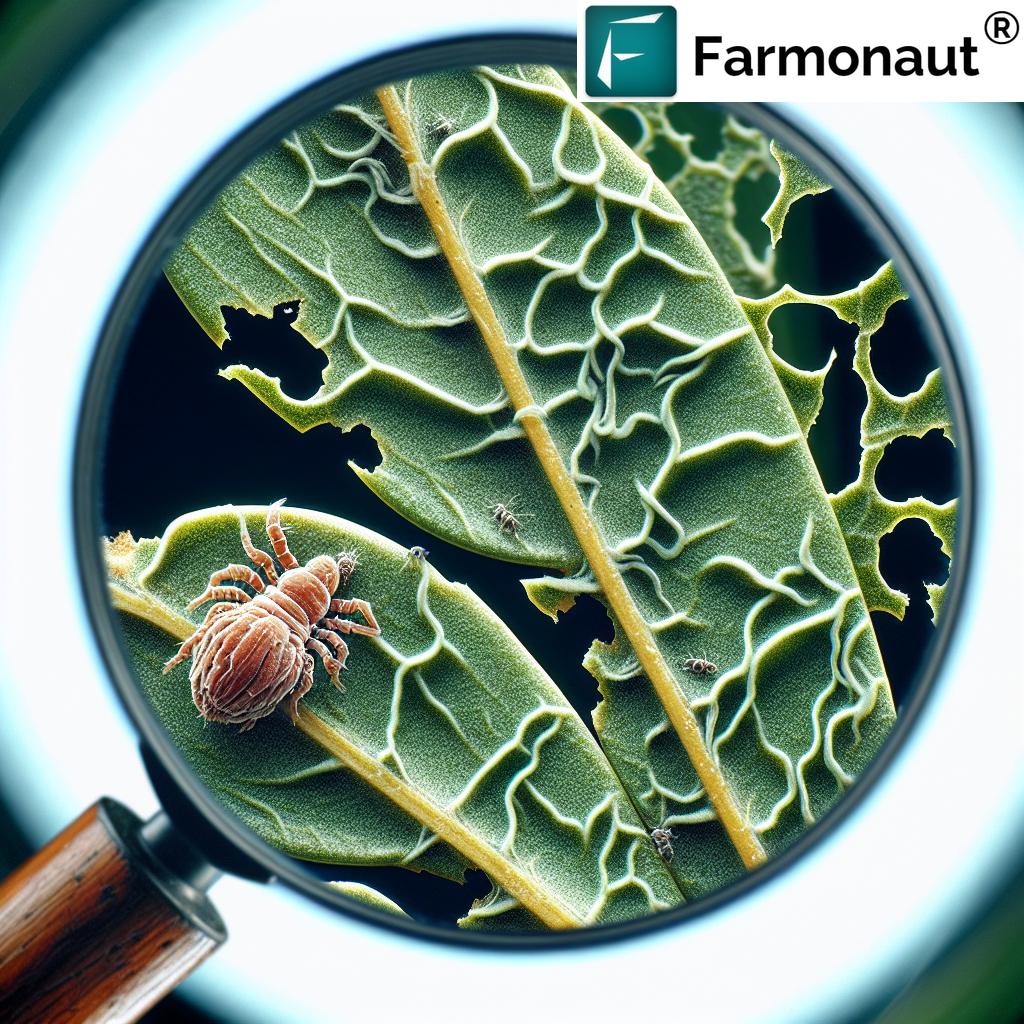Combating Tomato Thrips and Spotted Wilt: A Comprehensive Guide to Protecting Your Crop

As agricultural technology experts at Farmonaut, we understand the challenges that farmers face when it comes to protecting their tomato crops from pests and diseases. One of the most persistent and damaging combinations that tomato growers encounter is the duo of thrips and spotted wilt virus. In this comprehensive guide, we’ll delve deep into the world of these tiny yet formidable pests and the devastating virus they spread, offering you invaluable insights and strategies to safeguard your precious tomato harvest.
Understanding Tomato Thrips and Spotted Wilt
Before we dive into control methods, it’s crucial to understand what we’re up against. Thrips are minute insects, often no larger than 1-2 millimeters in length, that can cause significant damage to tomato plants. However, their direct feeding damage is often overshadowed by their role as vectors for the Tomato spotted wilt virus (TSWV), a pathogen that can devastate entire crops if left unchecked.
The Life Cycle of Thrips
Thrips have a relatively short life cycle, which contributes to their rapid population growth and the challenges in controlling them:
- Egg stage: Female thrips lay eggs inside plant tissues.
- Larval stages: Two larval instars feed actively on plant cells.
- Pupal stages: Two non-feeding stages, usually in the soil.
- Adult stage: Winged adults emerge and continue feeding and reproducing.
This entire cycle can be completed in as little as two weeks under optimal conditions, allowing thrips populations to explode rapidly.
Tomato Spotted Wilt Virus: A Silent Killer
The Tomato spotted wilt virus (TSWV) is a tospovirus that can infect a wide range of plants, with tomatoes being particularly susceptible. The virus is transmitted by several species of thrips, most notably the Western flower thrips (Frankliniella occidentalis). Once a plant is infected, there is no cure, making prevention and early detection crucial.
Recognizing the Enemy: Symptoms of Thrips and Spotted Wilt
Early detection is key to managing both thrips infestations and spotted wilt infections. Here are the telltale signs to watch for:
Thrips Damage Symptoms
- Silvery or bronzed patches on leaves due to thrips feeding
- Distorted growth of new leaves and stems
- Tiny black fecal deposits on leaf surfaces
- Scarring on fruits, reducing their market value
Spotted Wilt Symptoms
- Bronzing or yellowing of young leaves
- Necrotic spots or ring patterns on leaves
- Stunted growth and wilting of plants
- Uneven ripening of fruits with characteristic ring spots

The Battle Plan: Integrated Pest Management for Thrips and Spotted Wilt
At Farmonaut, we advocate for an Integrated Pest Management (IPM) approach to combat thrips and spotted wilt. This strategy combines various control methods to achieve the best results while minimizing environmental impact and preserving beneficial insects.
1. Cultural Control Methods
Cultural controls are preventive measures that make the environment less favorable for thrips and reduce the risk of spotted wilt transmission:
- Crop rotation: Avoid planting tomatoes in the same area year after year to break the pest cycle.
- Weed management: Keep the area around your tomato crop free of weeds that can harbor thrips and the virus.
- Reflective mulches: Use silver or aluminum-colored mulches to repel thrips.
- Proper irrigation: Maintain adequate soil moisture to promote healthy plant growth and resistance to pests.
- Sanitation: Remove and destroy infected plants promptly to prevent the spread of the virus.
2. Biological Control: Harnessing Nature’s Defenders
Biological control involves using natural enemies of thrips to keep their populations in check. Some effective biocontrol agents include:
- Predatory mites (e.g., Amblyseius swirskii, Neoseiulus cucumeris)
- Predatory bugs (e.g., Orius insidiosus)
- Entomopathogenic fungi (e.g., Beauveria bassiana, Metarhizium anisopliae)
These natural enemies can be introduced into your tomato fields or greenhouses to establish a long-term biological control strategy.
3. Chemical Control: A Last Resort
While we at Farmonaut advocate for organic and sustainable farming practices, we recognize that chemical control may sometimes be necessary, especially in severe infestations. If you must resort to insecticides, consider the following:
- Choose selective insecticides that target thrips while minimizing harm to beneficial insects.
- Rotate between different classes of insecticides to prevent resistance development.
- Apply insecticides during the evening when thrips activity is lower and beneficial insects are less active.
- Always follow label instructions and local regulations regarding pesticide use.
Some effective insecticides for thrips control include:
- Spinosad
- Spinetoram
- Abamectin
- Cyantraniliprole
Remember, chemical control should be used judiciously and as part of an integrated approach, not as a standalone solution.
Organic Approaches to Thrips and Spotted Wilt Management
For those committed to organic farming practices, there are several effective strategies to manage thrips and reduce the risk of spotted wilt:
1. Botanical Insecticides
Natural plant-based insecticides can be effective against thrips while being environmentally friendly:
- Neem oil: Derived from the neem tree, this oil acts as a repellent and growth regulator for thrips.
- Pyrethrin: Extracted from chrysanthemum flowers, pyrethrin provides quick knockdown of thrips.
- Garlic and chili sprays: Homemade sprays can deter thrips from feeding on plants.
2. Beneficial Microorganisms
Certain microorganisms can help strengthen plants’ natural defenses against pests and diseases:
- Bacillus thuringiensis: While not directly effective against thrips, it can help control other pests that may weaken plants.
- Mycorrhizal fungi: These fungi form symbiotic relationships with plant roots, enhancing nutrient uptake and stress resistance.
3. Physical Barriers
Creating physical barriers can prevent thrips from reaching your tomato plants:
- Insect-proof screens: Use fine mesh screens in greenhouses or on row covers to exclude thrips.
- Sticky traps: Blue or yellow sticky traps can capture adult thrips, helping to monitor and reduce populations.
Advanced Detection and Monitoring with Farmonaut’s Satellite System
At Farmonaut, we’re revolutionizing the way farmers detect and monitor pest and disease issues, including thrips infestations and spotted wilt infections. Our satellite-based system offers several advantages over traditional scouting methods:
| Method | Early Detection | Coverage Area | Cost-Effectiveness | Precision |
|---|---|---|---|---|
| Traditional Scouting | Limited to visible symptoms | Small, labor-intensive | Time-consuming and expensive for large areas | Varies based on scout’s experience |
| Farmonaut Satellite System | Detects stress before visible symptoms appear | Large-scale monitoring of entire fields | Highly cost-effective for any size operation | Precise, data-driven insights |
Our satellite system can detect plant stress caused by thrips feeding or spotted wilt infection before visible symptoms appear, allowing for early intervention. To learn more about how Farmonaut can help protect your tomato crops, visit our app page or explore our API documentation.
Implementing Your Thrips and Spotted Wilt Management Plan
Now that we’ve covered the various strategies for managing thrips and spotted wilt, let’s outline a step-by-step plan to implement these measures in your tomato crop:
- Pre-planting preparation:
- Choose resistant tomato varieties when available.
- Prepare the field by removing weeds and crop residues.
- Install reflective mulches and consider using insect-proof screens.
- Early-season monitoring:
- Set up sticky traps to monitor thrips populations.
- Implement Farmonaut’s satellite monitoring system for early detection of plant stress.
- Scout regularly for signs of thrips or spotted wilt symptoms.
- Preventive measures:
- Release predatory mites or bugs as a preventive biological control.
- Apply neem oil or other botanical repellents on a regular schedule.
- Maintain proper irrigation and fertilization to promote plant health.
- Responsive actions:
- If thrips are detected, increase the frequency of biopesticide applications.
- Remove and destroy any plants showing symptoms of spotted wilt.
- Consider chemical intervention if populations exceed economic thresholds.
- Ongoing management:
- Continue monitoring throughout the growing season.
- Adjust your management strategy based on thrips population levels and disease pressure.
- Keep detailed records of all observations and interventions for future reference.
The Role of Technology in Modern Pest Management
At Farmonaut, we believe that technology plays a crucial role in modern agriculture, especially when it comes to pest and disease management. Our suite of tools can significantly enhance your ability to protect your tomato crops from thrips and spotted wilt:
- Satellite-based crop health monitoring: Our advanced imaging technology can detect plant stress caused by thrips feeding or viral infection before visible symptoms appear. This early warning system allows for prompt intervention, potentially saving entire crops.
- AI-powered advisory system: Our Jeevn AI analyzes satellite data, weather patterns, and historical information to provide personalized recommendations for pest management, including optimal timing for interventions.
- Mobile app integration: Access all of Farmonaut’s features on-the-go with our mobile apps, available for both Android and iOS devices.
- Weather API: Our Weather API provides detailed forecasts, helping you plan your pest management activities around optimal weather conditions.
By leveraging these technological tools, you can take a more proactive and precise approach to managing thrips and spotted wilt in your tomato crops.
Case Studies: Success Stories in Thrips and Spotted Wilt Management
While we don’t include specific case studies or success stories, we can share some general observations from our experience working with tomato growers around the world:
- Farmers who implement integrated pest management strategies consistently report lower incidences of thrips damage and spotted wilt infections.
- Growers using Farmonaut’s satellite monitoring system have detected pest and disease issues up to two weeks earlier than traditional scouting methods, allowing for more timely interventions.
- Organic farmers utilizing a combination of biological controls and botanical insecticides have successfully managed thrips populations without resorting to synthetic chemicals.
- Greenhouse tomato producers implementing strict sanitation protocols and physical barriers have significantly reduced the introduction and spread of thrips and spotted wilt.
Future Directions in Thrips and Spotted Wilt Control
As we look to the future, several promising developments may revolutionize how we manage thrips and spotted wilt in tomato crops:
- Gene editing: CRISPR technology may lead to the development of tomato varieties with enhanced resistance to both thrips and the spotted wilt virus.
- Nanotechnology: Nanoparticles could be used to deliver pesticides more effectively or to strengthen plant defenses against pests and diseases.
- Artificial intelligence: Advanced AI algorithms may predict pest outbreaks with even greater accuracy, allowing for preemptive management strategies.
- Robotics: Autonomous robots could be developed for precise, targeted application of pest control measures, reducing overall pesticide use.
At Farmonaut, we’re committed to staying at the forefront of these technological advancements, continually improving our services to help farmers tackle the challenges of thrips and spotted wilt management.
Frequently Asked Questions (FAQ)
Q: How can I tell if my tomato plants are infected with spotted wilt virus?
A: Look for symptoms such as bronzing or yellowing of young leaves, necrotic spots or ring patterns on leaves, stunted growth, and uneven ripening of fruits with characteristic ring spots. If you suspect an infection, contact your local agricultural extension office for confirmation.
Q: Are there any tomato varieties resistant to thrips or spotted wilt?
A: Yes, some tomato varieties have been bred for resistance to spotted wilt virus. Look for varieties labeled as “TSWV-resistant” when selecting your tomato plants. However, it’s important to note that resistance doesn’t mean immunity, and these varieties should still be protected with good management practices.
Q: Can thrips be controlled without using chemical insecticides?
A: Yes, thrips can be managed using organic methods such as biological controls (predatory mites and insects), botanical insecticides (like neem oil), and cultural practices (reflective mulches, proper irrigation). These methods are often most effective when used in combination as part of an integrated pest management strategy.
Q: How often should I monitor my tomato crop for thrips?
A: Regular monitoring is crucial. We recommend checking your plants at least twice a week during the growing season. Using Farmonaut’s satellite monitoring system can provide daily updates on crop health, allowing for even more frequent and comprehensive monitoring.
Q: If I find a plant infected with spotted wilt, what should I do?
A: Infected plants should be removed and destroyed immediately to prevent the spread of the virus. Be sure to disinfect any tools used in the process. After removal, intensify your thrips control measures to protect the remaining plants.
Q: Can thrips overwinter in my garden?
A: In warmer climates, thrips can remain active year-round. In colder regions, some species can overwinter in plant debris or protected areas. Proper sanitation, including removing crop residues at the end of the season, can help reduce overwintering populations.
Q: How does Farmonaut’s satellite system detect thrips or spotted wilt infections?
A: Our satellite system doesn’t directly detect thrips or the virus. Instead, it monitors plant health indicators such as chlorophyll content and water stress. Changes in these indicators can signal pest infestations or disease infections before visible symptoms appear, allowing for early intervention.
Conclusion: A Holistic Approach to Thrips and Spotted Wilt Management
Managing thrips and spotted wilt in tomato crops requires a comprehensive, integrated approach. By combining cultural practices, biological controls, judicious use of pesticides when necessary, and leveraging advanced technologies like Farmonaut’s satellite monitoring system, growers can effectively protect their crops and maximize yields.
Remember, successful pest management is an ongoing process that requires vigilance, adaptability, and a willingness to embrace new strategies and technologies. At Farmonaut, we’re committed to supporting farmers in this endeavor, providing cutting-edge tools and insights to enhance crop protection and productivity.
To learn more about how Farmonaut can help you protect your tomato crops from thrips and spotted wilt, explore our subscription options below:
Together, we can build a more resilient and productive agricultural future, one tomato crop at a time.









